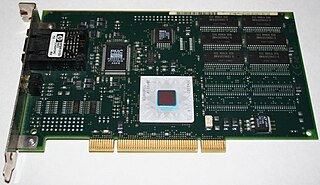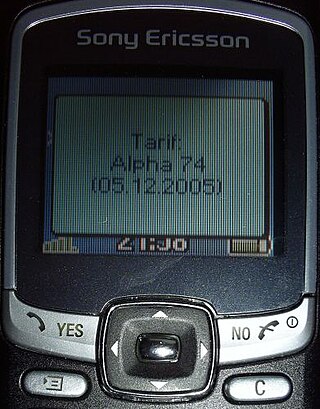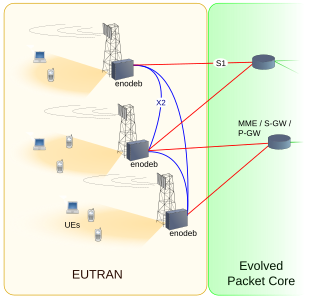
Asynchronous Transfer Mode (ATM) is a telecommunications standard defined by American National Standards Institute (ANSI) and ITU-T for digital transmission of multiple types of traffic. ATM was developed to meet the needs of the Broadband Integrated Services Digital Network as defined in the late 1980s, and designed to integrate telecommunication networks. It can handle both traditional high-throughput data traffic and real-time, low-latency content such as telephony (voice) and video. ATM provides functionality that uses features of circuit switching and packet switching networks by using asynchronous time-division multiplexing.

Enhanced Data rates for GSM Evolution (EDGE) also known as Enhanced GPRS (EGPRS), IMT Single Carrier (IMT-SC), or Enhanced Data rates for Global Evolution) is a digital mobile phone technology that allows improved data transmission rates as a backward-compatible extension of GSM. EDGE is considered a pre-3G radio technology and is part of ITU's 3G definition. EDGE was deployed on GSM networks beginning in 2003 – initially by Cingular in the United States.

The Global System for Mobile Communications (GSM) is a standard developed by the European Telecommunications Standards Institute (ETSI) to describe the protocols for second-generation (2G) digital cellular networks used by mobile devices such as mobile phones and tablets. GSM is also a trade mark owned by the GSM Association. GSM may also refer to the Full Rate voice codec.

General Packet Radio Service (GPRS) is a packet oriented mobile data standard on the 2G and 3G cellular communication network's global system for mobile communications (GSM). GPRS was established by European Telecommunications Standards Institute (ETSI) in response to the earlier CDPD and i-mode packet-switched cellular technologies. It is now maintained by the 3rd Generation Partnership Project (3GPP).
The Universal Mobile Telecommunications System (UMTS) is a third generation mobile cellular system for networks based on the GSM standard. Developed and maintained by the 3GPP, UMTS is a component of the International Telecommunication Union IMT-2000 standard set and compares with the CDMA2000 standard set for networks based on the competing cdmaOne technology. UMTS uses wideband code-division multiple access (W-CDMA) radio access technology to offer greater spectral efficiency and bandwidth to mobile network operators.
High-Level Data Link Control (HDLC) is a bit-oriented code-transparent synchronous data link layer protocol developed by the International Organization for Standardization (ISO). The standard for HDLC is ISO/IEC 13239:2002.

In IEEE 802 LAN/MAN standards, the medium access control sublayer is the layer that controls the hardware responsible for interaction with the wired, optical or wireless transmission medium. The MAC sublayer and the logical link control (LLC) sublayer together make up the data link layer. The LLC provides flow control and multiplexing for the logical link, while the MAC provides flow control and multiplexing for the transmission medium.
Mobility management is one of the major functions of a GSM or a UMTS network that allows mobile phones to work. The aim of mobility management is to track where the subscribers are, allowing calls, SMS and other mobile phone services to be delivered to them.
The Adaptive Multi-Rateaudio codec is an audio compression format optimized for speech coding. AMR speech codec consists of a multi-rate narrowband speech codec that encodes narrowband (200–3400 Hz) signals at variable bit rates ranging from 4.75 to 12.2 kbit/s with toll quality speech starting at 7.4 kbit/s.

Unstructured Supplementary Service Data (USSD), sometimes referred to as "quick codes" or "feature codes", is a communications protocol used by GSM cellular telephones to communicate with the mobile network operator's computers. USSD can be used for WAP browsing, prepaid callback service, mobile-money services, location-based content services, menu-based information services, and as part of configuring the phone on the network.
Adaptive Multi-Rate Wideband (AMR-WB) is a patented wideband speech audio coding standard developed based on Adaptive Multi-Rate encoding, using a similar methodology to algebraic code-excited linear prediction (ACELP). AMR-WB provides improved speech quality due to a wider speech bandwidth of 50–7000 Hz compared to narrowband speech coders which in general are optimized for POTS wireline quality of 300–3400 Hz. AMR-WB was developed by Nokia and VoiceAge and it was first specified by 3GPP.
GSM frequency bands or frequency ranges are the cellular frequencies designated by the ITU for the operation of GSM mobile phones and other mobile devices.
Customized Applications for Mobile networks Enhanced Logic (CAMEL) is a set of standards designed to work on either a GSM core network or the Universal Mobile Telecommunications System (UMTS) network. The framework provides tools for operators to define additional features for standard GSM services/UMTS services. The CAMEL architecture is based on the Intelligent Network (IN) standards, and uses the CAP protocol. The protocols are codified in a series of ETSI Technical Specifications.
In the GSM cellular mobile phone standard, timing advance (TA) value corresponds to the length of time a signal takes to reach the base station from a mobile phone. GSM uses TDMA technology in the radio interface to share a single frequency between several users, assigning sequential timeslots to the individual users sharing a frequency. Each user transmits periodically for less than one-eighth of the time within one of the eight timeslots. Since the users are at various distances from the base station and radio waves travel at the finite speed of light, the precise arrival-time within the slot can be used by the base station to determine the distance to the mobile phone. The time at which the phone is allowed to transmit a burst of traffic within a timeslot must be adjusted accordingly to prevent collisions with adjacent users. Timing Advance (TA) is the variable controlling this adjustment.

E-UTRA is the air interface of 3rd Generation Partnership Project (3GPP) Long Term Evolution (LTE) upgrade path for mobile networks. It is an acronym for Evolved Universal Mobile Telecommunications System (UMTS) Terrestrial Radio Access, also referred to as the 3GPP work item on the Long Term Evolution (LTE) also known as the Evolved Universal Terrestrial Radio Access (E-UTRA) in early drafts of the 3GPP LTE specification. E-UTRAN is the initialism of Evolved UMTS Terrestrial Radio Access Network and is the combination of E-UTRA, user equipment (UE), and E-UTRAN Node B or Evolved Node B (eNodeB).
SIM Application Toolkit (STK) is a standard of the GSM system which enables the subscriber identity module to initiate actions which can be used for various value-added services. Similar standards exist for other network and card systems, with the USIM Application Toolkit (USAT) for USIMs used by newer-generation networks being an example. A more general name for this class of Java Card-based applications running on UICC cards is the Card Application Toolkit (CAT).
The Short Message Service is realised by the use of the Mobile Application Part (MAP) of the SS7 protocol, with Short Message protocol elements being transported across the network as fields within the MAP messages. These MAP messages may be transported using "traditional" TDM based signalling, or over IP using SIGTRAN and an appropriate adaptation layer.
FCCH stands for Frequency Correction Channel. It is a downlink-only control channel in the GSM Um air interface. The FCCH burst, defined in GSM 05.02 section 5.2.4, is an all-zero sequence that produces a fixed tone in the GMSK modulator output. This tone enables the Mobile to lock its local oscillator to the BS clock as required in GSM specification 05.01 section 6. The FCCH is transmitted in frames immediately before the SCH.

The mobile switching station, abbreviated as MSC Server or MSS, is a 2G core network element which controls the network switching subsystem elements. Alternatively or adaptively, MSS can be used in GSM networks as well, if the manufacturer has implemented support for GSM networks in the MSS. Since an immediate upgrade of existing GSM network to 3G is not viable due to various issues like handset incompatibilities and high expenditure, most manufacturers do implement GSM support in MSS. In fact, MSS along with other 3G network elements such as media gateway (MGW), can be configured to support GSM network exclusively and can be considered as an upgraded version of existing GSM mobile switching centres. The MSC Server is standards-based and communicates with other distributed elements using industry open standards such as media gateway control protocol, megaco/H.248, Session Initiation Protocol, M2UA and M3UA. The MSC server incorporates industry standards as defined by ETSI, ITU, GSM, 3GPP and 3GPP2 and other leading standard bodies. The MSS supports the regulatory environment set by governing bodies via its support for E911, CALEA/legal intercept, wireless and local number portability, TTY/TTD, and Number Pooling requirements.
The Um interface is the air interface for the GSM mobile telephone standard. It is the interface between the mobile station (MS) and the Base transceiver station (BTS). It is called Um because it is the mobile analog to the U interface of ISDN. Um is defined in the GSM 04.xx and 05.xx series of specifications. Um can also support GPRS packet-oriented communication.







